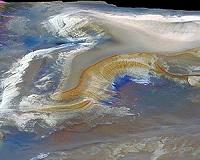 |
Pasadena CA (SPX) Aug 03, 2010 NASA and the European Space Agency (ESA) have embarked on a joint program to explore Mars in the coming decades and selected the five science instruments for the first mission. The principal investigator for one of the instruments, and the management for NASA's roles in the mission, are based at NASA's Jet Propulsion Laboratory, Pasadena, Calif. The ExoMars Trace Gas Orbiter, scheduled to launch in 2016, is the first of three joint robotic missions to the Red Planet. It will study the chemical makeup of the Martian atmosphere with a 1000-fold increase in sensitivity over previous Mars orbiters. The mission will focus on trace gases, including methane, which could be potentially geochemical or biological in origin and be indicators for the existence of life on Mars. The mission also will serve as an additional communications relay for Mars surface missions beginning in 2018. "Independently, NASA and ESA have made amazing discoveries up to this point," said Ed Weiler, associate administrator of NASA's Science Mission Directorate in Washington. "Working together, we'll reduce duplication of effort, expand our capabilities and see results neither ever could have achieved alone." NASA and ESA invited scientists worldwide to propose the spacecraft's instruments. The five selected were from 19 proposals submitted in January. Both agencies evaluated the submissions and chose those with the best science value and lowest risk. The selection of the instruments begins the first phase of the new NASA-ESA alliance for future ventures to Mars. The instruments and the principal investigators are: + Mars Atmosphere Trace Molecule Occultation Spectrometer - A spectrometer designed to detect very low concentrations of the molecular components of the Martian atmosphere: Paul Wennberg, California Institute of Technology, Pasadena, Calif. + High Resolution Solar Occultation and Nadir Spectrometer - A spectrometer designed to detect traces of the components of the Martian atmosphere and to map where they are on the surface: Ann C. Vandaele, Belgian Institute for Space Aeronomy, Brussels, Belgium. + ExoMars Climate Sounder - An infrared radiometer that provides daily global data on dust, water vapor and other materials to provide the context for data analysis from the spectrometers: John Schofield, NASA's Jet Propulsion Laboratory. + High Resolution Color Stereo Imager - A camera that provides four-color stereo imaging at a resolution of two million pixels over an 8.5 kilometer (5.3 mile) swath: Alfred McEwen, University of Arizona, Tucson. + Mars Atmospheric Global Imaging Experiment - A wide-angle, multi-spectral camera to provide global images of Mars in support of the other instruments: Bruce Cantor, Malin Space Science Systems, San Diego. The science teams on all the instruments have broad international participation from Europe and the United States, with important hardware contributions from Canada and Switzerland. "To fully explore Mars, we want to marshal all the talents we can on Earth," said David Southwood, ESA director for Science and Robotic Exploration. "Now NASA and ESA are combining forces for the joint ExoMars Trace Gas Orbiter mission. Mapping methane allows us to investigate further that most important of questions: Is Mars a living planet, and if not, can or will it become so in the future?" NASA and ESA share a common interest in conducting robotic missions to the Red Planet for scientific purposes and to prepare for possible human visits. After a series of extensive discussions, the science heads of both agencies agreed on a plan of cooperation during a July 2009 meeting in Plymouth, England, later confirmed by ESA Director General Jean-Jacques Dordain and NASA Administrator Charles Bolden in a statement of intent that was signed in November 2009. The plan consists of two Mars cooperative missions in 2016 and 2018, and a later joint sample return mission. The 2016 mission features the European-built ExoMars Trace Gas Orbiter, a European-built small lander demonstrator, a primarily-U.S. international science payload, and NASA-provided launch vehicle and communications components. ESA member states will provide additional instrument support. The 2018 mission consists of a European rover with a drilling capability, a NASA rover capable of caching selected samples for potential future return to Earth, a NASA landing system, and a NASA launch vehicle. These activities are designed to serve as the foundation of a cooperative program to increase science returns and move the agencies toward a joint Mars sample return mission in the 2020s. NASA's Mars Exploration Program seeks to characterize and understand Mars as a dynamic system, including its present and past environment, climate cycles, geology and potential for life. JPL, a division of Caltech, manages the program and development of the NASA-supplied instruments for the 2016 orbiter for NASA's Science Mission Directorate in Washington.
Share This Article With Planet Earth
Related Links NASA Mars programs Mars News and Information at MarsDaily.com Lunar Dreams and more
 DLR Investigates The Existence Of Liquid Salt Solutions On Mars
DLR Investigates The Existence Of Liquid Salt Solutions On MarsBonn, Germany (SPX) Jul 29, 2010 Is it possible that there are salt solutions on Mars that remain liquid despite the extremely low temperatures - a class of fluids known as cryobrines? Research findings at the German Aerospace Center have shown that this is a theoretical possibility. Experiments and modelling have indicated that the required conditions exist, especially during the Martian northern summer at higher latitud ... read more |
|
| The content herein, unless otherwise known to be public domain, are Copyright 1995-2010 - SpaceDaily. AFP and UPI Wire Stories are copyright Agence France-Presse and United Press International. ESA Portal Reports are copyright European Space Agency. All NASA sourced material is public domain. Additional copyrights may apply in whole or part to other bona fide parties. Advertising does not imply endorsement,agreement or approval of any opinions, statements or information provided by SpaceDaily on any Web page published or hosted by SpaceDaily. Privacy Statement |